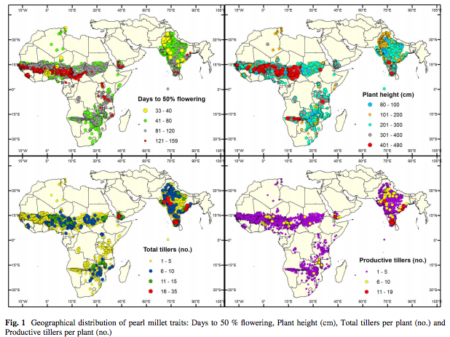![]() Our friends at ICRISAT have been busy describing their pearl millet collection, and their latest offering is a thorough analysis of the geographic distribution of morphological traits. That follows, among other things, a general review of the collection, and an analysis of latitudinal patterns in morphological diversity.
Our friends at ICRISAT have been busy describing their pearl millet collection, and their latest offering is a thorough analysis of the geographic distribution of morphological traits. That follows, among other things, a general review of the collection, and an analysis of latitudinal patterns in morphological diversity.
That last paper showed that although pearl millet landraces reach basically similar latitudes in both the N and S hemispheres (about 34°), there is much more cultivation north of the equator than south, as one would perhaps expect from the relative distribution of landmasses, except perhaps for the 15°–20° range, from which there is more cultivation south of the equator than north. Mid-latitude regions (15°–20°) in both hemispheres have proved the most useful as sources of material for developing high-yielding cultivars (they are early-maturing, producing long and thick panicles with large seeds). So it seems that southern hemisphere germplasm has a greater chance of being useful in breeding, although most cultivation is in the north. Another example of interdependence.
The latest paper ((Upadhyaya, H., Reddy, K., Ahmed, M., Kumar, V., Gumma, M., & Ramachandran, S. (2016). Geographical distribution of traits and diversity in the world collection of pearl millet [Pennisetum glaucum (L.) R. Br., synonym: Cenchrus americanus (L.) Morrone] landraces conserved at the ICRISAT genebank Genetic Resources and Crop Evolution DOI: 10.1007/s10722-016-0442-8)) goes in a lot more detail for individual traits. It’s very difficult to summarize patterns in 8 quantitative traits (days to 50% flowering, plant height, total and productive tillers per plant, panicle exsertion, length and thickness and 1000 seed weight) and 8 qualitative traits (panicle shape and density, bristle length, seed shape and color, endosperm texture, green fodder yield potential and seed yield potential) from 15,969 accessions from 30 countries. So I’ll limit myself to one recommendation. If you want to see huge variation in pearl millet height, go to Burkina Faso.
